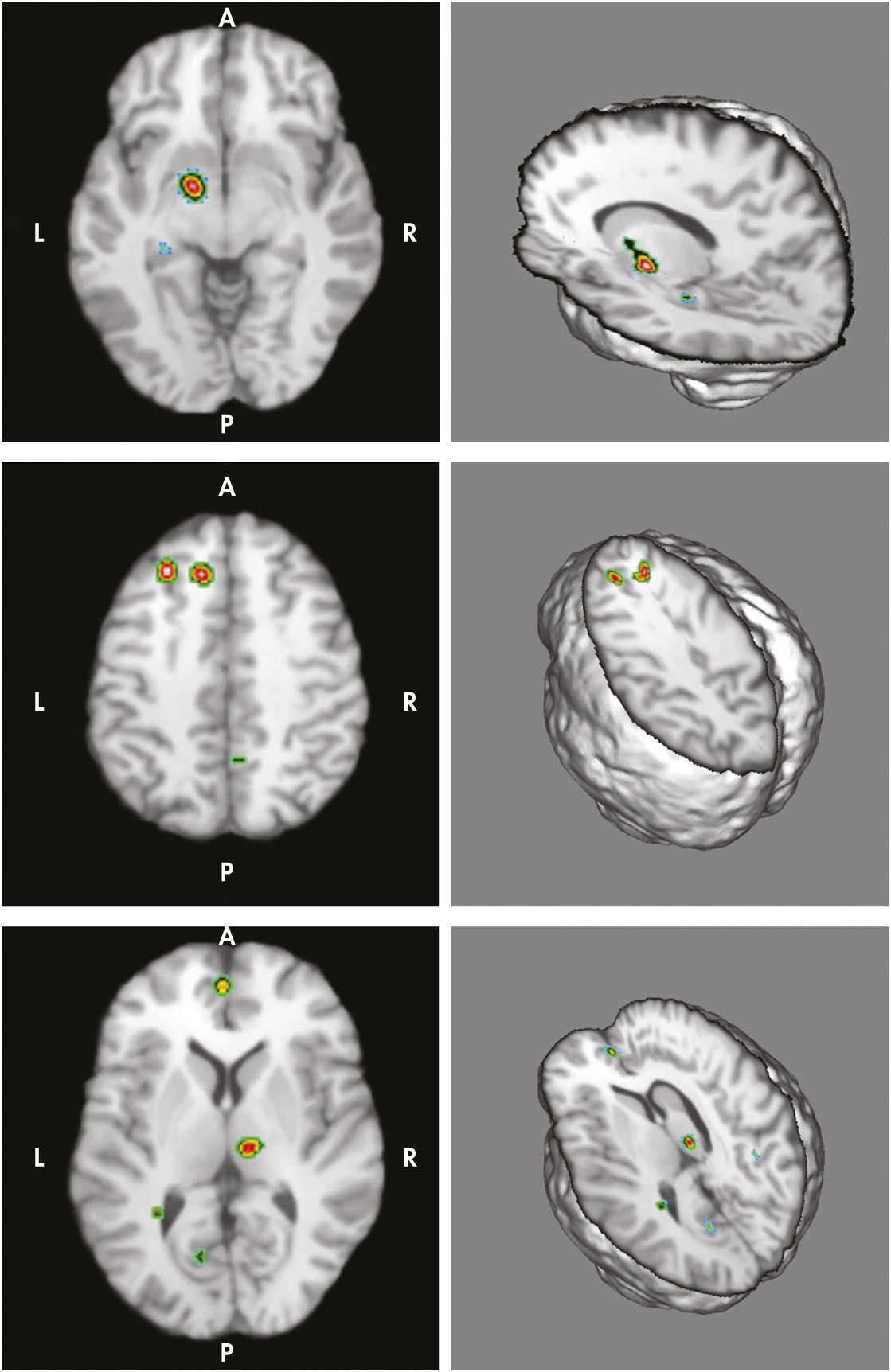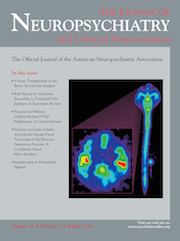Patterns of Cortico-Limbic Activations During Visual Processing of Sad Faces in Depression Patients: A Coordinate-Based Meta-Analysis
Abstract
Methods
Literature Selection and Data Collection
| Study | Subjects | Diagnostic Criteria | Patient Characteristics | Design (experimental task and condition) | Number of Foci | Statistical Threshold | Original Stereotaxic Space |
|---|---|---|---|---|---|---|---|
| Gotlib et al.21 | 18 patients versus 18 controls | DSM-IV | Depressed, medicated, recurrent | Sad versus neutral faces contrast; sex identification task (emotional [happy, sad, angry, fearful], neutral, and scrambled faces) | 1 | Uncorrected p <0.001 | Talairach and Tournoux |
| Keedwell et al.27 | 12 patients versus 12 controls | ICD–10 | Depressed, medicated, recurrent | Sad faces versus neural faces; mood-provocation paradigm; depression versus control contrast (all displaying mood-congruent [happy, sad, or neutral] facial expressions) | 7 | Uncorrected p=0.005 | Talairach and Tournoux |
| Surguladze et al.5 | 16 patients versus 14 controls | DSM-IV | Depressed, medicated, recurrent | Sad faces versus neutral faces; gender decision task; depression versus control contrast (20 happy, 20 neutral, and 20 sad faces) | 3 | Uncorrected p=0.003 | Talairach and Tournoux |
| Fu et al.4 | 19 patients versus 19 controls | DSM-IV | Depressed; drug-free, recurrent | Sad faces versus cross-hair fixation point; sad affect recognition task; depression versus control contrast (4 separate sessions: low, medium, high intensity of sad faces) | 89 | Uncorrected p <0.005 | Talairach and Tournoux |
| Chen et al.23 | 17 patients | DSM-IV | Depressed; medicated; recurrent | Sad faces versus cross-hair fixation points; Ekman series; Facial Affect-Processing Experiment; depression versus control contrast | 10 | Uncorrected p <0.005 | Talairach and Tournoux |
| Fu et al.24 | 19 patients and 19 controls | DSM-IV | Depressed, drug-naïve, first-episode | High-intensity sad faces versus cross-hair fixation-point; implicit sad facial-recognition task; depression versus control contrast (low, medium, high intensity of sad faces) | 13 | Uncorrected p<0.003 | Talairach and Tournoux |
| Fu et al.26 | 16 patients versus 16 controls | DSM-IV | Depressed, drug-free, recurrent | Sad faces versus cross-hair fixation-point; implicit sad facial-recognition task; depression versus control contrast (low, medium, high intensity of sad faces) | 9 | Uncorrected p<0.005 | Talairach and Tournoux |
| Suslow et al.29 | 30 patients, 26 controls | DSM-IV | Depressed; medicated, recurrent | Sad faces versus neutral faces; Ekman series; Facial Affect-Processing Experiment; depression versus control contrast | 1 | Uncorrected p=0.00039 | Montreal Neurological Institute |
| Study | Subjects | Diagnostic Criteria | Patient Characteristics | Design | Number of Foci | Statistical Threshold | Original Stereotaxic Space |
|---|---|---|---|---|---|---|---|
| Gotlib et al.21 | 18 patients versus 18 controls | DSM-IV | Depressed, medicated, recurrent | Sad-versus-neutral faces contrast; sex identification task; emotional (happy, sad, angry, fearful), neutral, and scrambled faces | 2 | Uncorrected p <0.001 | Talairach and Tournoux |
| Keedwell et al.27 | 12 patients versus 12 controls | ICD–10 | Depressed, medicated, recurrent | Sad faces versus neutral faces; mood-provocation paradigm; control versus depression contrast (all displaying mood-congruent {happy, sad, or neutral] facial expressions) | 3 | Uncorrected p=0.005 | Talairach and Tournoux |
| Lawrence et al.28 | 9 patients versus 11 controls | DSM-IV | Depressed; medicated; recurrent | Sad/neutral faces; facial identities task; control>depression contrast; (either sadness, happiness, or fear with different intensities) | 4 | Uncorrected p <0.005 | Talairach and Tournoux |
| Surguladze et al.5 | 16 patients versus 14 controls | DSM-IV | Depressed, medicated, recurrent | Sad faces; control versus depression contrast; gender decision task; 20 happy, 20 neutral, and 20 sad faces | 3 | Uncorrected p=0.003 | Talairach and Tournoux |
| Fu et al.4 | 19 patients versus 19 controls | DSM-IV | Depressed; drug-free, recurrent | Sad faces versus cross-hair fixation-point; sad affect recognition task; depression versus control contrast (4 separate sessions: low, medium, high intensity of sad faces) | 0 | Uncorrected p <0.005 | Talairach and Tournoux |
| Fu et al.25 | 19 patients versus 19 controls | DSM-IV | Depressed; medicated; recurrent | Sad faces versus cross-hair fixation-points; facial sad faces task; control versus depression contrast (low, medium, high intensity of emotional faces) | 19 | Uncorrected p <0.005 | Talairach and Tournoux |
| Fu et al.24 | 19 patients and 19 controls | DSM-IV | Depressed, drug-naïve, first-episode | High-intensity sad faces versus cross-hair fixation-points; sad facial recognition task; depression versus control contrast (low, medium, high intensity of sad faces) | 12 | Uncorrected p <0.005 | Talairach and Tournoux |
| Fu et al.26 | 16 patients versus 16 controls | DSM-IV | Depressed, drug-free, recurrent | Sad faces versus cross-hair fixation-points; implicit sad facial recognition task; depression versus control contrast (low, medium, high intensity of sad faces) | 17 | Uncorrected p <0.005 | Talairach and Tournoux |
Meta-analysis Procedure
Results
Clusters of Activation in “Depression Versus Control” and “Control Versus Depression” Meta-Analysis

Discussion
Conclusions
Acknowledgments
References
Information & Authors
Information
Published In
History
Authors
Metrics & Citations
Metrics
Citations
Export Citations
If you have the appropriate software installed, you can download article citation data to the citation manager of your choice. Simply select your manager software from the list below and click Download.
For more information or tips please see 'Downloading to a citation manager' in the Help menu.
View Options
View options
PDF/EPUB
View PDF/EPUBLogin options
Already a subscriber? Access your subscription through your login credentials or your institution for full access to this article.
Personal login Institutional Login Open Athens loginNot a subscriber?
PsychiatryOnline subscription options offer access to the DSM-5-TR® library, books, journals, CME, and patient resources. This all-in-one virtual library provides psychiatrists and mental health professionals with key resources for diagnosis, treatment, research, and professional development.
Need more help? PsychiatryOnline Customer Service may be reached by emailing [email protected] or by calling 800-368-5777 (in the U.S.) or 703-907-7322 (outside the U.S.).

